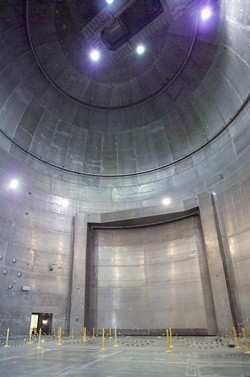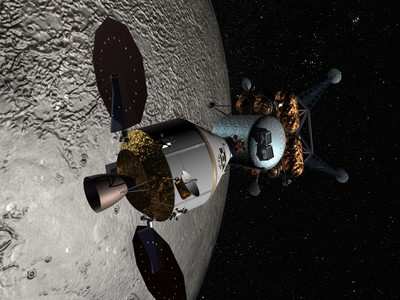Only Facility In US Able To Test Fully Assembled
Spacecraft
 Before NASA's new manned
spacecraft, Orion, carries the next generation of explorers into
space, it first will make a shorter journey to the world's largest
vacuum chamber. In this massive, cathedral-like structure, it will
go through a variety of rigorous challenges.
Before NASA's new manned
spacecraft, Orion, carries the next generation of explorers into
space, it first will make a shorter journey to the world's largest
vacuum chamber. In this massive, cathedral-like structure, it will
go through a variety of rigorous challenges.
Called the Space Power Facility, the vacuum chamber -- located
at NASA Glenn Research Center's Plum Brook Station in Sandusky, OH
-- measures 100 feet in diameter and towers at 122 feet tall. Its
size and ability to simulate the vacuum of space make it ideal for
testing the Orion crew exploration vehicle, according to NASA.
Scheduled to make its first flights early in the next decade,
Orion is part of NASA's Constellation Program to send human
explorers back to the moon and then onward to Mars and other
destinations in the solar system.
The fully assembled spacecraft will stand 75 feet tall and
include a crew module to carry the astronauts; a service module to
provide power, propulsion and communications; a launch abort system
for emergency escapes; and an adapter to connect the spacecraft to
its launch system.
But before NASA can launch Orion, the agency "must demonstrate
that the vehicle is capable of withstanding the harsh environment
of space," said Robert Moorehead, Director of Space Flight Systems
at Glenn. "The Space Power Facility will help us do that."
In 2008, workers will begin modifying the building to
accommodate these tests. A new vibration and acoustic test chamber,
a mechanical vibration test stand and electromagnetic interference
equipment will enable the facility to simulate the conditions Orion
must endure on its mission.
"The Space Power Facility will be the only facility in the U.S.,
if not the world, that can perform complete environmental testing
on a fully assembled spacecraft," said David Stringer, director of
Plum Brook Station.
The new reverberant acoustic chamber will subject Orion to the
intense vibrations and shockwaves it will encounter during launch
and ascent. In the vacuum chamber, infrared lamps and cold walls
flushed with liquid nitrogen will simulate the extreme hot and cold
temperatures of space.
The electromagnetic interference tests will also take place
inside the vacuum chamber, which blocks radio frequencies and cell
phone signals. Electromagnetic interference equipment positioned on
moving platforms will challenge the reliability of Orion's
communications and electronics systems, according to the
agency.
Built in 1969, the Space Power Facility has tested the
International Space Station's radiator and solar arrays, the Mars
rover landing systems, and most of the nation's major rockets,
including Atlas and Delta. With the upgrades, the Plum Brook
facility also will be well suited to test next-generation lunar
landers, robotic systems, and military and commercial
spacecraft.

"Plum Brook will have an important role to play in the future
exploration of space," said NASA's Associate Deputy Administrator
Charles Scales. "It's hard to believe that in less than two
decades, people will look up and, with nothing but a strong
telescope, see the shining lights of a research center on the
moon."
 Sierra Space Repositions Dream Chaser for First Mission
Sierra Space Repositions Dream Chaser for First Mission ANN's Daily Aero-Term (05.10.24): Takeoff Roll
ANN's Daily Aero-Term (05.10.24): Takeoff Roll Aero-News: Quote of the Day (05.10.24)
Aero-News: Quote of the Day (05.10.24) Aero-News: Quote of the Day (05.11.24)
Aero-News: Quote of the Day (05.11.24) ANN's Daily Aero-Term (05.11.24): IDENT Feature
ANN's Daily Aero-Term (05.11.24): IDENT Feature




